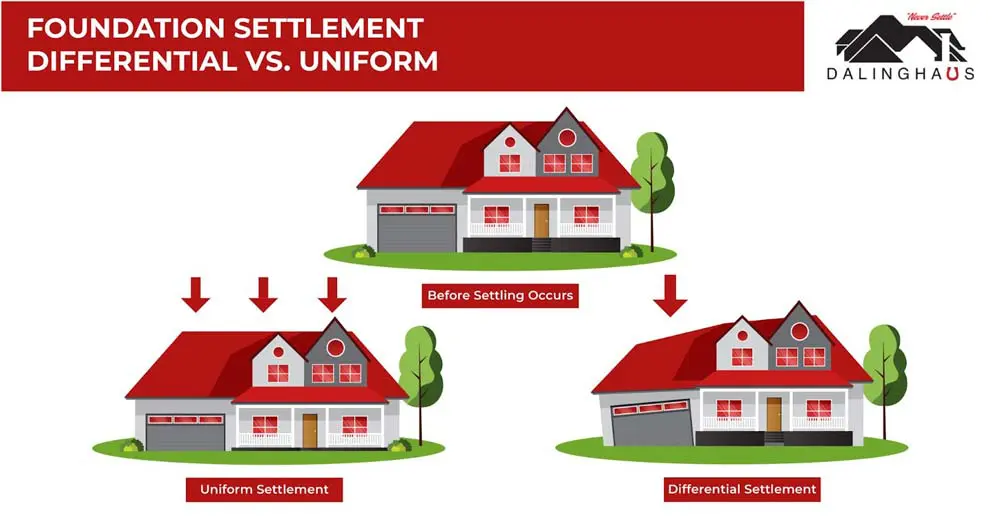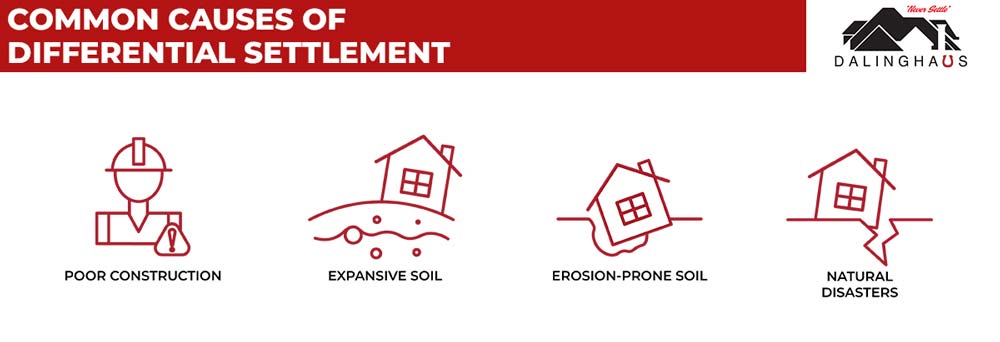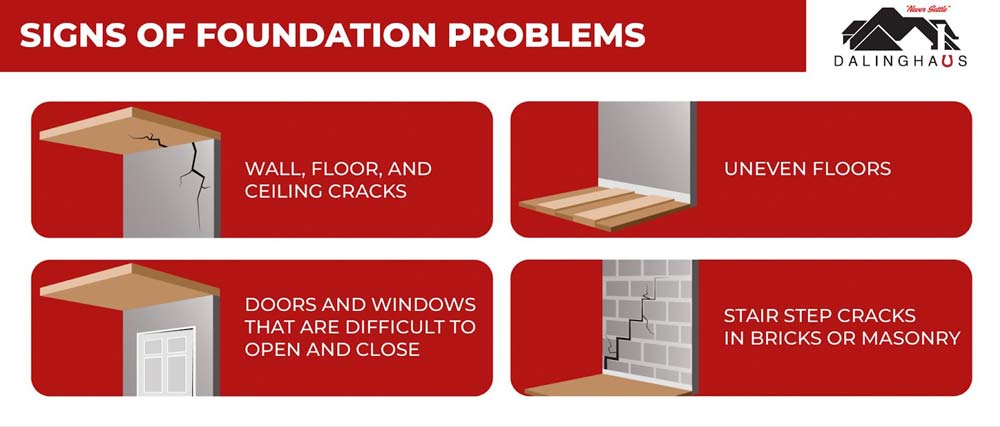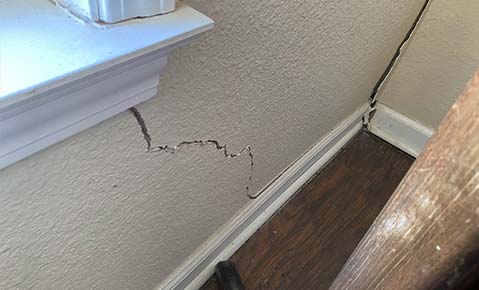Are you a homeowner dealing with an old house that has uneven floors? If you’ve noticed that your floor slopes in certain areas, then you’ve landed on the right page. Over time and for various reasons, floors in an old house can become unlevel. In this article, we are going to explore some of those exact reasons. So, keep reading to discover what causes uneven floors in older homes, along with how they can be made level again.
What Causes Uneven Floors in an Old House?
Two common causes of uneven floors in an old house are differential foundation settlement and problems with the wooden support structures in the crawl space, if you have a crawl space foundation.
Differential Foundation Settlement
Differential foundation settlement refers to when different parts of a building’s foundation settle into the ground at varying rates. The best way to describe this is through an illustration:

This differential movement can cause cracks and other types of structural damage that can compromise the safety and stability of the building. To prevent such incidents, it is crucial to understand the leading causes of differential foundation settlement:

- Improper site preparation – Soil needs to be adequately compacted before anything gets built on top of it. When it is not compacted correctly, it can become displaced or compressed over time, causing the foundation to settle into the ground unevenly.
- Expansive clay soil – Expansive soil, which swells when exposed to moisture, is another leading cause of differential foundation settlement since it causes movement under the foundation. Over time, this can lead to differential settlement and its associated problems.
- Erosion-prone soil – Some types of soil are prone to erosion. When the soil underneath a building’s foundation washes away or erodes, it can cause the foundation to shift unevenly.
- Seismic events – Earthquakes can cause cracking, shifting, and other damage to the foundation–especially when the soil is not adequately stabilized. This can result in uneven floors.
Problems with the Wooden Structures in the Crawl Space
Issues with the wooden support structures in the crawl space can also cause uneven floors in an older house. Common problems include the following:
Deterioration
The crawl space’s wooden support structures are susceptible to deterioration and rotting. This happens because the crawl space is often damp and humid, which encourages mold and mildew growth. The mold eats away at the cellulose in the wood fibers, and they decay. This leads to a weakening of the structural integrity of the support system, making it unable to properly carry the weight of the house. As a result, the floors in an old home–which depend on the wooden supports beneath them–can become uneven.
Termites and Other Wood-Eating Pests
Termites and other pests can make the crawl space their home, leading to extensive damage to the wooden supports.
Settlement
Uneven floors in an old house can also be caused by crawl space support posts that have settled into the ground and become non-vertical. This might happen due to soggy soil caused by poor drainage around the foundation. This settling puts uneven pressure on the wooden support structures, causing them to bear weight unevenly.
Why You Don’t Want to Leave Uneven Floors Unrepaired
Since an uneven floor in an old house is often caused by a foundation issue or problem in the crawl space, leaving it unrepaired can lead to more significant structural issues that will be more expensive to fix if you wait.
Ignoring foundation problems can also affect the resale value of your home. An uneven floor caused by a foundation issue could make it harder to sell your home in the future, and could impact the price you receive if you decide to sell.
How to Level Floors in an Old House
The chosen repair solution will depend on what caused the floor to become uneven in the first place. If the issue results from differential settlement, house leveling can be done through underpinning. If a problem in the crawl space caused the uneven floor, the solution will be different.
Underpinning to Correct an Uneven Floor
Underpinning is the process of strengthening the foundation by adding depth and support to it. This is achieved by installing push, helical, or slab piers. Push piers are made of steel and are driven into the ground until they reach stable, load-bearing soil or rock. Helical piers have a corkscrew-like shape and are twisted into the ground. They also provide additional foundation support and can be used in areas unsuitable for push piers. Slab piers are push or helical piers that are installed through holes cut in the slab. For more information, see our article What Does Underpinning A House Mean?
Leveling an Uneven Floor Caused by a Problem in the Crawl Space
In cases where uneven floors are caused by issues in the crawl space, possible repair solutions include the following:
- Replacement or adjustment of the support posts
- Installing additional support piers
- Replacing settled or deteriorated support posts with adjustable screw jacks
- Sistering weakened joists
Is Floor Leveling a DIY Project?
Floor leveling is not a DIY project. Attempting to level a floor without proper knowledge and experience may lead to disastrous outcomes, such as uneven floors, weak subfloors, and even structural damage to the building. This is because floor leveling requires a comprehensive understanding of the building’s foundation, subflooring, and the materials needed to achieve the desired results. Additionally, the work involves specialized tools and equipment.
Hiring a professional contractor for floor leveling is essential to ensuring that the job is done correctly, safely, and efficiently. Professionals have the technical know-how and experience to identify the root cause of the unevenness and develop appropriate solutions that will not compromise the integrity of the building.
Benefits of Leveling Floors in an Old House
There are several benefits to repairing a foundation problem, including:
- Preventing further damage – One of the most significant advantages is preventing further damage to the property. If left unrepaired, these issues can become more severe over time, leading to even more costly and time-consuming repairs in the future.
- Increased home value – By fixing problems related to the foundation, homeowners can increase the market value of their property and make it more attractive to potential buyers. Many real estate experts recommend repairing foundation problems before placing a home on the market to ensure a timely and profitable sale.
- Lower energy costs – Damaged foundations can cause air leaks and temperature variations, making heating and cooling systems less effective and leading to higher energy bills. A repaired foundation can improve the overall energy efficiency of a home, resulting in lower utility bills and a more comfortable living space.
- Ensure the home’s safety and stability – A damaged foundation can create hazardous situations such as uneven floors or shifting walls. Repairing these issues can provide a solid and secure foundation for homeowners, ensuring that their property is safe and secure for years to come.
Cost of Leveling Floors in an Old House
The cost of underpinning a foundation using push, helical, or slab piers can vary greatly depending on the severity of the problem, the size of the area that needs underpinning, and the type of foundation construction. Generally, underpinning a foundation can cost between $1,000 to $3,000 per installed pier.
As for fixing the wooden structures in the crawl space, this type of repair is usually less expensive than underpinning a foundation. The cost to replace support posts or install adjustable screw jacks typically ranges from $500 to $2,000. The cost will depend on the extent of the damage, the type of material needed, and the labor required to perform the task.
Common Signs of a Foundation Problem
A homeowner’s best strategy is to be vigilant, look out for any signs of foundation problems, and address them as soon as possible. Here are the leading signs to be on the lookout for:

- Cracks in walls, ceilings, and floors – Cracks wider than 1/8th of an inch are a red flag, indicating possible foundation issues.
- Uneven or sloping floors – If you notice that your floors slope or are uneven, it could indicate a problem with your foundation.
- Sticking doors and windows – When doors or windows suddenly start to stick, jam, or become hard to open or close, this can indicate a foundation problem that has thrown everything out of order.
- Stair step cracks in brick or masonry – This is a telltale sign of a foundation problem.
If you spot any of these signs, don’t hesitate to call a foundation repair specialist to assess and fix the problem before it escalates. Foundation issues that are spotted early cost less to repair.
If you have an older home with an uneven floor, contact us today to schedule an inspection and receive a repair estimate. We serve Southern California, Arizona, and Nevada.






